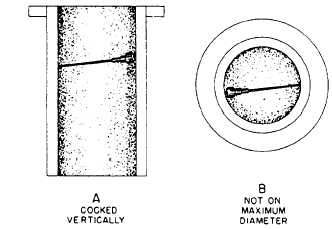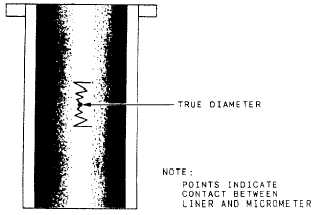Figure 3-7.—Errors to avoid when taking liner measurements.
Figure 3-8.—Trace of caliper end when determining the true
diameter of a liner.
practice for two persons to take the liner measurement;
then any discrepancy between the two sets of readings
can be rechecked.
Causes
Excessive or abnormal wear of cylinder liners may
be caused by insufficient lubrication, dirt, improper
starting procedures, or low cooling water temperature.
The lubricating system must be carefully
maintained in proper working order. The method of
cylinder liner lubrication varies with different engines.
The proper grade of oil, according to engine
specifications, should be used
The engine must not be operated in a dirty condition.
The air box, crankcase, and manifold should be cleaned
and maintained in a clean condition, to avoid cylinder
wear and scoring. (Attention to the air cleaner, oil filters,
and oil centrifuge are the best precautions against the
entrance of dirt into the engine.)
Improper starting procedures will cause excessive
wear on the liners and pistons. When an engine is first
started, some time may elapse before the flow of
lubricating oil is completed; also, the parts are cold and
condensation of corrosive vapors is accelerated
accordingly. These two factors (lack of lubrication and
condensation of corrosive vapors) make the period
immediately after starting a critical time for cylinder
liners. If an independently driven oil pump is installed,
it must be used to prime the lube oil system and build
up oil pressure before the engine is started The engine
should not be subjected to high load during the warm-up
period. Follow the manufacturer’s instruction manual
concerning warm-up time and load application for the
engine concerned
The cooling water of an engine should always be
maintained within the specified temperature ranges. If
the temperature is allowed to drop too low, corrosive
vapors will condense on the liner walls.
Repairs
Cylinder liners worn beyond the maximum
allowable limit should be replaced. You will find the
maximum allowable wear limits for engines in the
appropriate manufacturer’s technical manual or the
Diesel Engine Wear Limit Chart available from the
Naval Sea Systems Command. In the absence of such
specific information, the following wear limits
(established by NAVSEA) apply in general to
1. two-stroke cycle engines with aluminum
pistons: 0.0025 inch per inch diameter,
2. slow-speed engines over l8-inch bore: 0.005
inch per inch diameter, and
3. all other engines: 0.003 inch per inch diameter.
If you must remove a liner, follow the instructions
given on the appropriate maintenance requirement card
(MRC) or in the manufacturer’s technical manual for the
particular type of engine. Figure 3-9 illustrates the
method generally used to remove a cylinder liner.
To remove the cylinder liner, proceed as follows:
1. Drain the water from the engine.
2. Remove the cylinder head.
3. Remove the piston(s).
3-6




